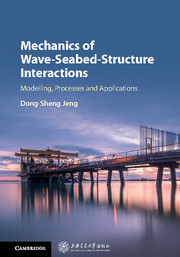Book contents
- Frontmatter
- Contents
- Preface
- 1 Overview
- 2 Basic Seabed Mechanisms
- 3 Soil Response in Marine Sediments under Combined Loading of Waves and Currents
- 4 Integrated Model of Wave-Seabed Interactions around Caisson-Type Breakwaters
- 5 Mechanics of Wave-Seabed-Pipeline Interactions
- 6 Three-Dimensional Model of Wave-Seabed Interactions around Breakwater Heads
- 7 Seabed Instability around Offshore Wind Turbine Foundations
- 8 Physical Modelling: One-Dimensional Compressive Tests
- Appendix A Analytical Solution for a Seabed of Finite Thickness (Hsu & Jeng 994)
- Appendix B Derivation of u–p Approximation (Jeng et al. 1999)
- Appendix C Derivation of u–U Approximation (Cha et al. 2002)
- Appendix D Mathematical Derivations of Analytical Solutions for Residual Soil Response (Jeng et al. 2007)
- Appendix E Mathematical Model of the Two-Layered Viscous Fluid System (Liu et al. 2009)
- References
- Author Index
- Subject Index
1 - Overview
Published online by Cambridge University Press: 28 April 2018
- Frontmatter
- Contents
- Preface
- 1 Overview
- 2 Basic Seabed Mechanisms
- 3 Soil Response in Marine Sediments under Combined Loading of Waves and Currents
- 4 Integrated Model of Wave-Seabed Interactions around Caisson-Type Breakwaters
- 5 Mechanics of Wave-Seabed-Pipeline Interactions
- 6 Three-Dimensional Model of Wave-Seabed Interactions around Breakwater Heads
- 7 Seabed Instability around Offshore Wind Turbine Foundations
- 8 Physical Modelling: One-Dimensional Compressive Tests
- Appendix A Analytical Solution for a Seabed of Finite Thickness (Hsu & Jeng 994)
- Appendix B Derivation of u–p Approximation (Jeng et al. 1999)
- Appendix C Derivation of u–U Approximation (Cha et al. 2002)
- Appendix D Mathematical Derivations of Analytical Solutions for Residual Soil Response (Jeng et al. 2007)
- Appendix E Mathematical Model of the Two-Layered Viscous Fluid System (Liu et al. 2009)
- References
- Author Index
- Subject Index
Summary
Background
Marine geotechnics is a multidisciplinary research theme covering conventional civil engineering disciplines such as fluid mechanics, coastal engineering, geotechnical engineering and structural engineering. This research area has attracted great attention among coastal and geotechnical engineers due to the growing activities in marine environments worldwide. An appropriate design for the foundations of marine infrastructures such as breakwaters, offshore pipelines, platforms and offshore wind turbine systems plays an important role in the success of offshore engineering projects. The evaluation of the soil response to hydrodynamic loading such as waves and currents around foundations of marine structures and the resultant seabed instability is one of the key factors in the design of foundations.
When a coastal structure is installed in a marine environment, the presence of the structure will alter the flow patterns in its immediate neighbourhood. The flow condition around the structure not only affects the wave force acting on the structure, but also induces seafloor instability. The former has been the main concern in the design of coastal structures, and has been intensively studied by coastal and structural engineers in the past. However, the latter involves the foundations of the structure, and has attracted attention from coastal geotechnical engineers in recent years.
In the past few decades, considerable efforts have been devoted to the phenomenon of wave-soil-structure interactions. The major reason for the growing interest is that many coastal structures (such as vertical walls, caissons, offshore monopiles and pipelines) have been damaged by the wave-induced seabed response, rather than from construction deficiencies (Christian, Taylor, Yen & Erali 1974; Smith & Gordon 1983; Lundgren, Lindhardt & Romold 1989). It has been reported in the literature that concrete armour blocks at the toes of a marine structure subsided into the seabed, and wave-induced liquefaction and shear failure have been identified as the culprit for this problem (Silvester & Hsu 1989). Another reason is that poro-elastic theories for wave-soil interactions have been applied to field measurements, such as the determination of the shear modulus of soil (Yamamoto & Trevorrow 1991) and the directional spectra of ocean surface waves (Nye & Yamamoto 1994), as well as acoustic waves propagating through porous media (Yamamoto & Turgut 1988).
When water waves propagate in the ocean, they generate significant dynamic pressures on the seafloor. These dynamic pressures further induce pore-water pressure and effective stresses within the seabed.
- Type
- Chapter
- Information
- Mechanics of Wave-Seabed-Structure InteractionsModelling, Processes and Applications, pp. 1 - 33Publisher: Cambridge University PressPrint publication year: 2018



